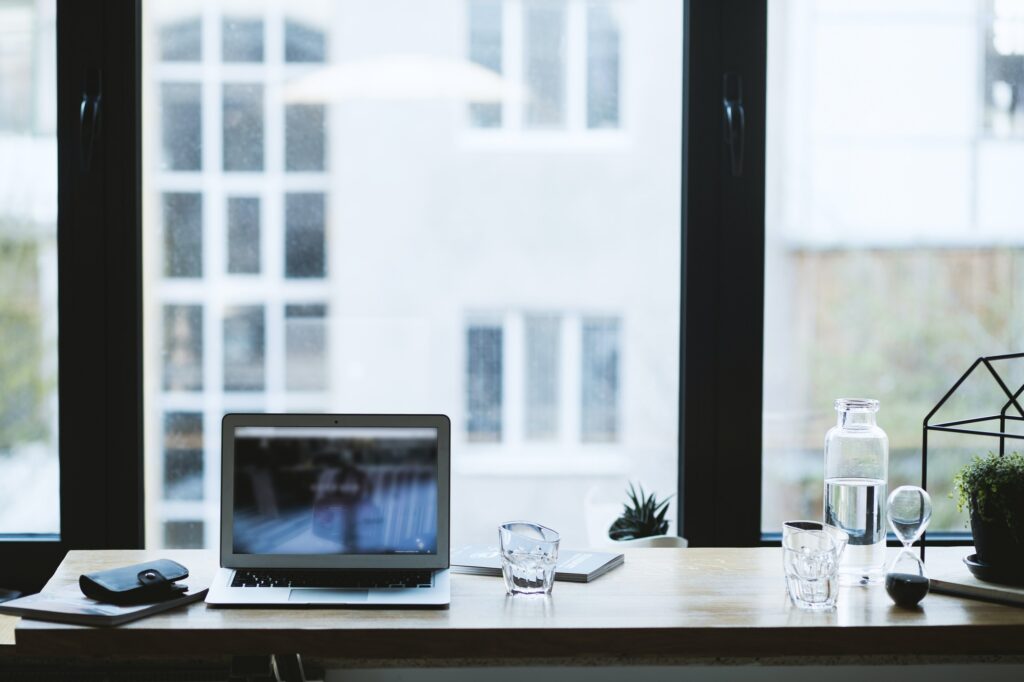Working from home has become a reality for many people around the world. While it has its benefits, it can also pose some challenges when it comes to setting up a productive workspace. One of the important factors to consider while designing your workspace is the direction you face.
Facing the wrong direction can seriously hamper your ability to be productive. And take away the joy of working from home.
But how do you decide which direction to face when working from home? Continue reading to get the answer.
If you just want a quick answer to what direction you should face when working from home, you can use the principles of Vastu Shastra. Vastu Shastra is somewhat similar to Feng Shui.
Vastu Shastra advises setting up your home office in the west or southwest part of your home for a productive and stable work life. Colours like cream, light yellow, green, or gold are recommended for promoting engagement, health, and positivity.
Position your desk in the southwest direction and sit facing northeast for improved concentration. Important files should be stored in the west or southwest, opening to the north, east, or northeast.
Vastu Shastra and Feng Shui share some similarities. Both are ancient practices that provide guidelines for the design and arrangement of spaces to optimize the flow of energy, improve harmony, and bring benefits to the inhabitants. However, they originate from different cultures and have unique methodologies and principles.
Vastu Shastra is an Indian practice rooted in Hindu traditions. It emphasizes the balance of the five elements (earth, water, fire, air, and space) and is deeply linked with cardinal directions. It often involves specific rules related to the placement of different rooms and elements within a building.
Feng Shui, on the other hand, is a Chinese practice that focuses on the flow of “chi” or “qi” (life force or energy) and the balance of yin and yang – opposite forces believed to make up the universe. Feng Shui uses tools like the Ba Gua map and compass (Lo Pan) to analyze spaces and determine the best arrangements for furniture and other elements.
While both practices aim to create harmonious living and working environments, their specific recommendations can differ based on their unique philosophical underpinnings and cultural origins.

The Importance of Facing the Right Direction
When it comes to setting up a home office, there are many factors to consider, such as the type of furniture, the color of the walls, the number of accessories to choose, and the lighting.
However, one aspect that is often overlooked is the direction you face while working. It might come as a surprise, but studies show that the direction you face can have a significant impact on your productivity, health, and well-being.
Imagine working in a space that makes you feel uncomfortable, disturbed, disoriented, paranoid cramped, and uninspired. It’s not a pleasant experience, and it can affect your work output.
That’s why it’s crucial to choose the right direction for your home office to make the most of your work hours.
The Direction's Impact on Productivity
Research* has found that people who face a certain direction while working report higher productivity levels than those facing the other direction.
For example, facing east can provide you with the morning sun, which can help you feel more alert and energized.
On the other hand, facing west can be distracting as the sun sets and creates glare on your computer screen. Therefore, it’s essential to consider the direction of your home office while setting it up to maximize your productivity.
However, whether or not it is the actual direction or the sun that affects it, that doesn’t really matter. What matters is that you can work uninterrupted by distractions caused by a certain direction.
*Source: https://pubmed.ncbi.nlm.nih.gov/8886377/
Effects on Mental Health and Well-being
Being exposed to natural light and having a view of the outside can have a significant impact on your mental health and well-being.
Research has shown that people who work in offices with windows have better sleep quality, higher levels of physical activity, and a better quality of life.
In contrast, those who work in windowless offices report more significant levels of stress, poorer sleep quality, and lower job satisfaction. Therefore, it’s essential to consider the psychological impact while finalizing the direction you face while working from home.
As such a good rule of thumb is to choose a direction facing a window. That lets in lots of light and lets you take your mind off of work by looking at the surroundings.
Influence on Creativity and Focus
The direction you face can also influence your creativity and focus. Facing a wall might be monotonous and distract you from work. However, facing a window with a beautiful view can stimulate your creativity and provide you with a calming atmosphere to work in.
If you don’t have a window, you can consider placing artwork or plants in front of you to provide a visual break from your work. You can choose fake plants as well if you don’t want to take care of them often.

Facing the Right Direction: Find a Natural Light Source
While it may seem like a small detail, facing natural light sources can have a big impact on your workday. Not only can it improve your mood, but it can also enhance your focus and promote better sleep quality.
But why is that? Well, below I will dive into what the benefits of facing natural when working from home are.
Benefits of Facing Natural Light
As mentioned earlier, natural light provides more than just illumination. It’s a source of vitamin D that can have numerous benefits for your health and well-being.
For example, exposure to natural light can help regulate your circadian rhythm, which can improve your sleep quality. Additionally, natural light has been shown to boost productivity and reduce stress levels, making it an important consideration for any home office setup.
If you feel tired or lazy when working from home, it might be that you are facing the wrong direction. And by “wrong direction” I mean facing away from the natural light.
How to Maximize Natural Light in Your Workspace
If you have a window in your home office, try to place your desk such that you have an unobstructed view of the window. This way, you can take breaks to look outside and give your eyes some relief. Moreover, take advantage of the natural light to reduce the need for artificial lighting that can cause eye strain.
It will also save you some money on the energy bill if you let the Sun shine instead of all of your lamps.
Another way to maximize natural light in your workspace is to use light-colored walls and furniture. This will help reflect the natural light and make the room feel brighter and more open. Unless you want a dark and moody home office, then this advice should be really helpful in order to lighten up your home office.
Additionally, consider using sheer curtains or blinds that can be easily adjusted to let in more or less light as needed.
But What to do if You Have No Natural Light to Face?
While natural light is ideal for any workspace, not all home offices have access to it. If your workspace is located in a basement, garage, under the stairs, etc. or if it just doesn’t have any windows, it can be a bit challenging to design. However, introducing bright artificial lighting can be the key.
Choose appropriate lighting fixtures that mimic natural light and provide a comfortable working environment. Additionally, consider using light therapy lamps that can simulate natural light and help regulate your circadian rhythm.
You can also add some plants suited for low light or fake plants that require no light at all. Then you can face in their direction when working from home and get some contrast to the walls around you.

How to Succeed with Facing a Window
The location of windows in your home office is a crucial factor when deciding the direction you face while working from home. Let’s dive deeper into understanding the role of window placement.
Windows not only provide natural light but also have a significant impact on the overall ambiance of your workspace. The right placement of windows – or placements near the window – can make your workspace feel more spacious and inviting. It can also improve your mood and help you stay focused throughout the day.
Pros and Cons of Facing a Window
Facing a window can have its benefits, such as natural light and an outside view, but it also poses some challenges.
The constant change in lighting and external distractions like people or traffic can be a hindrance. If you easily get distracted, then facing a window towards a heavily trafficked view might not be the best.
However, if you live in an area with a beautiful view, facing a window can be a great way to boost your creativity and make working from home much more enjoyable.
Pros and Cons of Facing Away from a Window
When you face away from a window, you have more control over the lighting in your workspace. It also reduces the chances of getting distracted by external factors.
However, it’s essential to ensure that your workspace has adequate artificial lighting to compensate for the lack of natural light. You can also consider using light therapy lamps to improve your mood and energy levels.
Also, if you face away from a window then you can get glare on your computer screen. This makes it harder to work. Unless you work from home without a computer.
Consider if the Window Placement Even Makes Sense For You
It’s essential to balance window placement with other factors when designing your workspace. Consider the location of electrical outlets, furniture placements, and other practical aspects while finalizing the direction you face while working from home. Also, the size of your home office dictates whether it is possible or not to sit near and face the window.
If you miss out on important stuff such as storage units, functioning office tables, and a chair by sitting close to the window it might not be worth it. Ergonomics and functionality should always come first.
Conclusion: Choosing The Right Direction to Face When Working From Home
Choosing the direction you face while working from home is a critical aspect of setting up a productive workspace. It affects your focus, creativity, and physical well-being.
While following principles such as Vastu Shastra or Feng Shui can be beneficial, ensure that you consider practical aspects such as the placement of natural light sources and window placement also.
Remember, your workspace should be personalized to cater to your specific needs and promote productivity and efficiency. And you should also feel good while working from home. You can take inspiration from the “hygge home office” to make your home office even more inviting and cozy.
My name is Frederik
I am a passionate marketeer who loves the freedom that comes with working from home whenever I choose to do so.
I love getting nerdy with every single detail about making everything related to my home just a tiny bit better.
That is what motivates me to write about home stuff on this blog.
-
Frederik Fisker Waehrenshttps://myeasyhomelife.com/author/frederik-fisker-waehrens/
-
Frederik Fisker Waehrenshttps://myeasyhomelife.com/author/frederik-fisker-waehrens/
-
Frederik Fisker Waehrenshttps://myeasyhomelife.com/author/frederik-fisker-waehrens/
-
Frederik Fisker Waehrenshttps://myeasyhomelife.com/author/frederik-fisker-waehrens/


